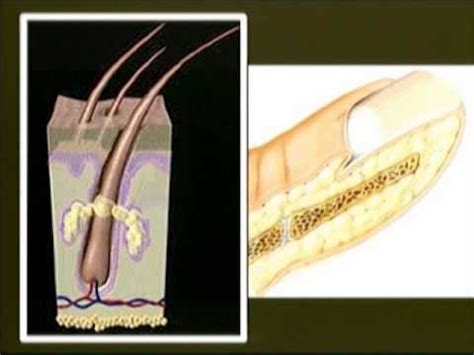Do Hair And Fingernails Grow After You Die
Juapaving
Apr 03, 2025 · 4 min read

Table of Contents
Do Hair and Fingernails Grow After You Die? A Deep Dive into Postmortem Changes
The question of whether hair and fingernails continue to grow after death is a common one, often fueled by folklore and anecdotal evidence. The truth, however, is more nuanced and fascinating than a simple yes or no. This article delves into the science behind postmortem changes, exploring the processes that occur after death and clarifying the misconceptions surrounding hair and nail growth.
Understanding the Biology of Growth
Before addressing the postmortem scenario, let's understand how hair and fingernails grow during life. Hair growth originates from the hair follicle, a small, complex organ located in the dermis (the deeper layer of skin). Cells within the follicle multiply and differentiate, pushing older cells upwards to form the hair shaft. This process requires a constant supply of nutrients and oxygen, facilitated by a network of blood vessels.
Similarly, fingernails, and toenails, are formed by specialized cells at the base of the nail called the matrix. These cells produce keratin, a tough protein that makes up the nail plate. Like hair growth, nail growth also relies on a steady supply of nutrients and oxygen delivered via the circulatory system.
The Cessation of Life Processes
When death occurs, the circulatory system fails. This means the flow of oxygen and nutrients to all cells, including those in the hair follicles and nail matrices, abruptly stops. Without these vital supplies, cell division and differentiation cease. This effectively halts the growth of hair and fingernails. The widely held belief that hair and nails continue to grow after death is therefore incorrect.
The Illusion of Growth: Dehydration and Skin Retraction
So why does it seem like hair and nails grow after death? The answer lies in the postmortem changes that affect the body's appearance. After death, the body begins to dehydrate. As the skin loses moisture, it retracts, revealing more of the hair shaft and nail bed. This creates the illusion of growth, as the already existing hair and nails appear longer relative to the shrinking surrounding tissue. This is especially noticeable in individuals with longer hair or nails.
The Role of Dehydration
Dehydration is a key factor. As fluids are lost, the skin around the hair follicles and nail beds shrinks. This retraction pulls back the skin, giving the appearance that the hair and nails are lengthening. This is a purely visual effect, not actual growth.
Other Postmortem Changes
Several other postmortem changes can contribute to the misconception. These include:
- Rigor mortis: The stiffening of muscles after death can alter the appearance of the hands and feet, potentially influencing the perceived length of fingernails.
- Decomposition: The process of decomposition can also create distortions that make hair and nails seem longer. This is a complex process involving enzymatic breakdown and bacterial action.
- Environmental factors: Exposure to certain elements or environmental conditions can also alter the appearance of the body, leading to misinterpretations regarding hair and nail growth.
The Significance of Understanding Postmortem Changes
Understanding the actual processes involved in postmortem changes is crucial for several reasons:
- Forensic science: Accurate assessment of postmortem changes is essential in forensic investigations for determining time of death and other crucial aspects.
- Medical science: Studying postmortem changes helps in advancing our understanding of the human body and the process of decomposition.
- Cultural and religious practices: Accurate information dispels misconceptions and helps clarify certain cultural and religious beliefs surrounding death.
Debunking Common Myths
Several persistent myths surround the growth of hair and fingernails after death:
- Myth: Hair and nails continue to grow for several days or weeks after death. Reality: Growth stops immediately upon death due to the cessation of blood flow and nutrient supply. Any perceived growth is purely an illusion created by postmortem changes.
- Myth: Hair and nail growth is a sign of the body's continued vitality. Reality: This is incorrect; the process is entirely due to the dehydration and retraction of the skin.
- Myth: Certain individuals may experience continued hair and nail growth due to unique biological factors. Reality: No scientific evidence supports this.
Conclusion: The Science Behind the Illusion
In conclusion, the belief that hair and fingernails grow after death is a common misconception. While the appearance of hair and nails may change after death due to dehydration and skin retraction, this is not actual growth. The processes of cell division and differentiation, essential for hair and nail growth, cease upon death due to the complete failure of the circulatory system. Understanding the scientific basis of postmortem changes is crucial for dispelling myths and clarifying the reality of what happens to the body after death. The illusion of continued growth is a testament to the body's complex processes and the subtle ways in which it changes after life ends. This understanding is important for various fields, from forensic science to cultural practices, and it highlights the ongoing fascination with the intricate and often unexpected mechanisms of death and decay.
Latest Posts
Latest Posts
-
Whats The Square Root Of 576
Apr 04, 2025
-
A Tropic Hormone Is Any Hormone That
Apr 04, 2025
-
Common Factors Of 24 And 30
Apr 04, 2025
-
How Many Gallons In 2 5 Liters
Apr 04, 2025
-
Compare And Contrast Inexhaustible Renewable And Nonrenewable Resources
Apr 04, 2025
Related Post
Thank you for visiting our website which covers about Do Hair And Fingernails Grow After You Die . We hope the information provided has been useful to you. Feel free to contact us if you have any questions or need further assistance. See you next time and don't miss to bookmark.
